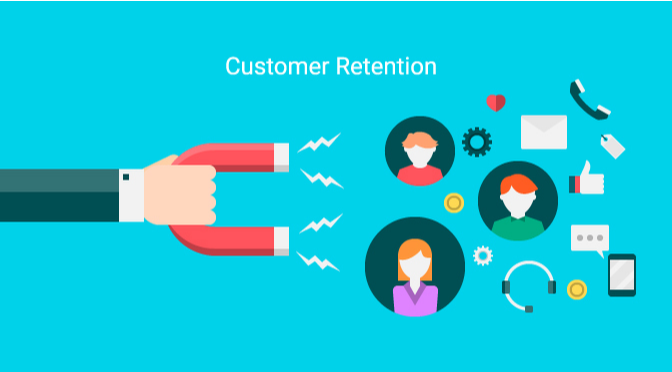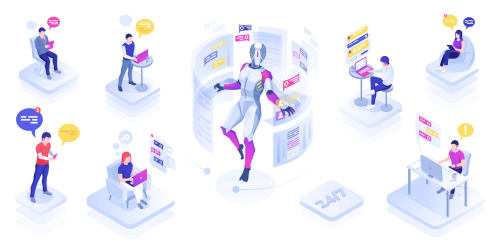AI Churn: Predict and Prevent Using AI in Customer Service
Customer churn (AKA customer attrition) costs businesses tons of money every year. In fact, it’s been reported by The Forester that it can cost as much as 5x more to acquire a new customer than it is to maintain an existing one. Furthermore, KPMG has released data indicating that retaining customers is the primary factor affecting a company’s revenue.
AI and machine learning can automate customer retention and predict customer churn by analyzing extensive customer data, identifying patterns in customer behaviors, and offering targeted retention strategies. Additionally, analyzing customer sentiment can help predict customer behavior and reduce churn. Businesses must keep customer churn as low as possible.
Understanding Customer Churn
Customer churn refers to the number of customers who terminate their relationship with a company within a given period. This metric is critical for businesses as it directly impacts revenue and customer lifetime value. When customers drop off, it not only results in immediate revenue loss but also affects the long-term profitability of the business. Understanding customer churn is essential for developing effective strategies to reduce it and improve customer retention rates. Various factors can contribute to customer churn, including poor customer experience, lack of engagement, and competitive offerings. By comprehensively understanding these factors, businesses can take proactive measures to enhance customer loyalty and extend the customer lifetime.
What are the Top Reasons for Customer Churn?
Customer churn, or attrition, occurs when customers discontinue their relationship with a business or service. Understanding how many customers discontinue their relationship over time is crucial for analyzing customer churn. Customer success leaders play a vital role in conducting customer churn analysis, examining why paid subscribers cease using a SaaS product. Analyzing customer behavior and interactions can help identify reasons for customer churn by understanding their preferences, sentiment, and the factors leading to their decision to leave. Several common reasons for customer churn include:
Poor Customer Service: Inadequate or unresponsive customer support, slow issue resolution, and unsatisfactory interactions can lead to customer dissatisfaction.
Competitive Offers: Customers may switch to competitors offering better pricing, features, or incentives.
Product or Service Issues: Frequent product defects, outages, or service disruptions can frustrate customers and drive them away.
Lack of Personalization: Customers increasingly expect personalized experiences. Failure to use data from customer interactions to offer relevant content, recommendations, or services can result in churn.
Unmet Expectations: When customers’ expectations are not met, whether in terms of product performance, service quality, or delivery, they may seek alternatives.
How Customer Churn is Expensive for Businesses in Terms of Customer Lifetime Value
While it’s fairly intuitive, it is important to point out that losing customers is going to create a loss of revenue for a business. Customers who decide to move on to another company may spread negative information about the company they left and generally, a loss of customers leads to a bad word of mouth. This forces businesses to respond to negative rumors by running more marketing campaigns and devoting energy to addressing poor publicity.
Customer churn directly impacts customer lifetime value, reducing the total revenue expected from a customer throughout their lifecycle. Therefore, maintaining customer loyalty is crucial for sustaining revenue and minimizing churn. Improving customer experience is essential to reduce customer churn, as it enhances design elements and user flow, and allows for timely interventions based on churn predictions.
All of these factors cost companies time and money.
Customer Churn Indicators Based on Customer Behavior
Luckily, there are things to look out for that can prevent customer churn before it happens. One such indicator is the amount of and nature of customer support tickets. For example, customers may be growing increasingly frustrated by a certain element of your business or your service.
The easiest way to identify these indicators and make appropriate changes is to leverage AI technology for churn prediction. Well-designed AI can send you an alert if you receive a high number of at-risk customer support issues or when an overall negative sentiment seems to be developing around your business. Analyzing customer sentiment using AI and machine learning can help predict customer behavior and reduce churn by employing natural language processing to glean insights from various customer interactions.
Historical data plays a crucial role in identifying churn patterns by analyzing past customer behavior and events. This helps in creating accurate forecasts of future churn rates and prioritizing retention strategies.
Early indicators of customer churn are critical for businesses to detect and address issues before customers discontinue their relationships. Some common early warning signs of customer churn include:
Decreased Engagement: A decline in customer engagement, such as reduced interaction with your product or service, fewer logins, or decreased usage, can be a warning sign that customers are losing interest.
Increased Support Tickets: A sudden uptick in customer support inquiries or complaints may signal dissatisfaction or difficulties with your offering.
Missed Payments or Late Payments: Customers who start missing payments or become consistently late in their payments may be experiencing financial difficulties or contemplating switching to a more cost-effective alternative.
Negative Feedback or Reviews: Monitoring customer feedback, online reviews, or social media comments can reveal dissatisfaction and potential churn triggers.
Reduced Interaction: If customers stop opening emails, clicking on links, or responding to communication, it could indicate waning interest.
Use of Competitor’s Products: When customers begin using a competitor’s product or service, it’s a strong indicator that they are exploring alternatives.
Declining User Activity: A drop in user activity or a decrease in the frequency of specific actions (e.g., shopping cart abandonment, reduced content consumption, etc.) may signify impending churn.
The Role of AI in Customer Churn Prediction
Artificial intelligence (AI) plays a pivotal role in predicting customer churn. AI algorithms can sift through vast amounts of customer data, including historical data, customer behavior, and customer interactions, to identify patterns that signal potential churn. These AI-powered predictive models enable customer success teams to prioritize preventative actions, thereby reducing customer churn. By leveraging AI, businesses gain valuable insights into customer behavior, allowing them to develop targeted strategies to retain customers. This proactive approach not only helps in retaining customers but also enhances overall customer success by addressing issues before they escalate.
Collecting and Analyzing Customer Data
Collecting and analyzing customer data is fundamental to understanding customer behavior and predicting churn. Customer data can be gathered from various sources, such as customer interactions, transactions, and feedback. By analyzing this data, businesses can identify patterns and trends that may indicate a higher likelihood of churn. Customer success teams can utilize data analytics tools to delve into customer data, uncovering insights that inform targeted strategies to reduce churn. This data-driven approach ensures that businesses can address potential issues early, enhancing customer satisfaction and retention.
Customer Journey Mapping and Churn Prevention
Customer journey mapping is a critical step in understanding customer behavior and preventing churn. By mapping out the customer journey, businesses can pinpoint pain points and areas where customers are more likely to churn. This comprehensive understanding of the customer journey allows businesses to develop targeted strategies to improve the customer experience and reduce churn. By identifying opportunities to engage with customers and provide personalized support, businesses can significantly reduce the likelihood of churn. This proactive approach not only enhances customer satisfaction but also fosters long-term customer loyalty.
Creating Smarter Customer Segments
Creating smarter customer segments is essential for developing targeted strategies to reduce churn. By segmenting customers based on their behavior, preferences, and needs, businesses can tailor their approaches to engage with customers more effectively. Smarter customer segments can be created using data analytics tools and AI-powered predictive models. By analyzing customer data, businesses can identify patterns and trends that help them develop personalized strategies to retain customers. This targeted approach ensures that businesses can address the unique needs of different customer segments, enhancing overall customer engagement and retention.
How can IrisAgent's AI and Machine Learning help prevent customer churn?
IrisAgent’s AI can help address customer churn quickly and effectively in several ways by analyzing patterns in customer behaviors. Additionally, understanding customer sentiment can help predict customer behavior and reduce churn by employing natural language processing to glean insights from various customer interactions. Two of these ways include:
Predictive Analytics: AI can analyze historical customer data to identify patterns and predict potential churn. By recognizing early signs of dissatisfaction or reduced engagement, AI can trigger proactive interventions to implement targeted retention strategies.
By integrating IrisAgent with your sales CRM, you can easily identify how likely customer churn will occur and how much it will cost you.
By integrating IrisAgent with your business’s analytics software, you can gain insight into when product usage is decreasing or when customers are having difficulty with certain elements of your service. Understanding the customer journey can help in offering timely interventions.
Automated Customer Feedback Analysis: AI can automatically analyze customer feedback, such as surveys, chat transcripts, and social media comments, to detect recurring issues and sentiment trends. This allows support teams to address problems before they lead to churn.
Personalized Support: AI can use customer data to provide personalized support experiences, such as tailored product recommendations, content, or promotions, which enhance customer satisfaction and retention.
Chatbots and Virtual Assistants: Chatbots powered by AI can handle routine customer inquiries and provide 24/7 assistance, improving response times and ensuring that customers receive help whenever needed.
Self-Service Options: AI-driven self-service solutions, like knowledge bases and FAQs, allow customers to find answers to common questions independently, reducing the need to contact support.
Issue Resolution: AI can assist in diagnosing and resolving customer issues more quickly and accurately, leading to higher satisfaction and lower churn rates.
Automated Follow-Ups: AI can send automated follow-up messages to check on customer satisfaction after interactions with support, providing an opportunity to address any remaining concerns.
Proactive Communication: AI can notify customers about upcoming updates, new features, or promotions relevant to their interests, keeping them engaged and informed.
Customer Success Team: AI can assist the customer success team in using predictive analytics to optimize retention strategies, identify churn patterns, and prioritize actions to improve customer retention.
It is significantly more expensive to acquire new customers than to keep existing customers. Preventing customer churn leads to a better reputation, increased revenue, and a better experience for both the customer and the company.
Interested in seeing how IrisAgent can help your business prevent churn? Check out our website!




